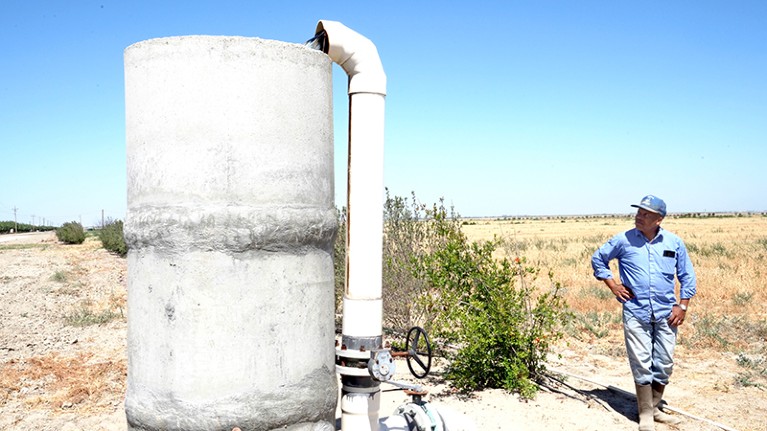
Groundwater pumped on to Dennis Hutson’s farm in Allensworth, California, had dangerously high levels of arsenic. New technology tested on the farm reduced the levels to drinking-water standard.Credit: Adam Lau/UC Berkeley
In 2022, Ashok Gadgil conducted the first field trial of a water-treatment system for the 600 or so residents of Allensworth, California, who have been battling arsenic contamination for some time. The system is a more efficient iteration of technology that Gadgil and his team installed in India in 2016 to provide rural and marginalized communities with access to safe drinking water at low cost1. Like many small rural communities, Allensworth — a historically Black town with a majority Latinx population today — has no access to high-quality surface-water treatment facilities that are common in urban areas. Instead, these communities often use wells, which are at high risk of contamination with arsenic and other toxic substances.
It’s an urgent issue in California: roughly 300,000 of the state’s 39 million residents drink from wells in the state’s rural areas and are therefore exposed to high levels of arsenic in the ground water. “Safe drinking water, which is a big chunk of our work, is all related to rural areas,” says Gadgil, who worked as an environmental engineer for 35 years at the state’s Lawrence Berkeley National Laboratory, and in July assumed an emeritus role at the University of California (UC), Berkeley. His team plans to return to Allensworth next year to continue testing the system, which makes use of technology, developed by a team that included Gadgil’s colleague Siva Bandaru, that uses hydrogen peroxide to rapidly oxidize iron so that it binds to arsenic and removes it from water.
California, like many US states, has a mounting number of rural concerns, including not just safe water supplies, but also wildfire preparedness, air quality and equitable access to health care. Researchers in the UC system have key roles in monitoring and addressing such concerns. In addition to the ten academic campuses spread across the state, the UC system has a network of Agriculture and Natural Resources extension centres that serve as bridges to rural areas. Roughly 270 researchers are employed by these centres to support all 58 state counties through collaboration with other UC teams, as well as working with other public and private organizations. And even though funds for these centres have been waning over the past two decades, they are currently allocated around US$100 million of the UC system’s US$47-billion budget for 2022–23 to rebuild their dwindling workforces.
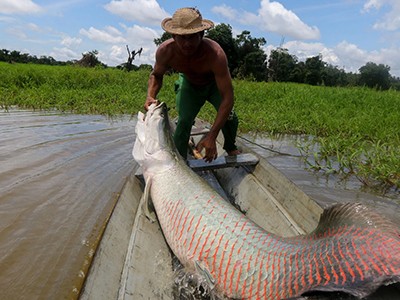
Millions of jobs in food production are disappearing — a change in mindset would help to keep them
It’s a welcome boost for researchers who face unique challenges in rural settings, where the remoteness of the communities can be a barrier to participation and engagement and cultural differences and concerns about confidentiality can cause some residents to be wary of academics. The most successful collaborations between urban-based researchers and rural communities have been based on a commitment to building trust, bridging political divides and delivering meaningful results, say researchers with experience in these settings.
A growing number of scientists are pursuing community-based research partnerships2. A common motivation, says Gadgil, is a sense of urgency in addressing environmental-justice issues, especially in historically excluded communities. Researchers at public universities, such as those in the UC system, often have a sense of responsibility to give back to the citizens that fund their mission, he says, adding that some of the most satisfying projects use innovative technologies to find solutions to these communities’ problems. “Scientists are always looking for new frontiers,” says Gadgil.
The regional contribution of the UC system is also apparent from Nature Index data on science cities (see ‘Deep connections’ and ‘Slipping back’).
Centring community voices
Table of Contents
Ann Cheney, a medical anthropologist at UC Riverside, conducts health research in partnership with communities living near the Salton Sea, California’s largest saline lake, roughly 50 kilometres north of the Mexican border. Over the past few decades, the lake has been shrinking owing to drought and reduced run-off from agriculture, which has increasingly exposed the lake bed. This has become a growing source of dust in a region that already has higher than average rates of childhood asthma compared with the rest of the state3.
In 2017, Cheney and her colleagues worked with researchers at the US Border Health Commission to identify the health needs of Mexican immigrants in rural southern California. Childhood health was at the top of the list. Since then, she has partnered with local groups to further analyse health impacts, particularly in undocumented immigrants. A major challenge, she says, is that many of these communities have grown resentful of urban academics who — backed by hefty grants — swoop in to collect their data but then fail to return with solutions. “My fear, and what I’ve already seen happen, is the continued exploitation of these incredibly vulnerable communities,” Cheney says.
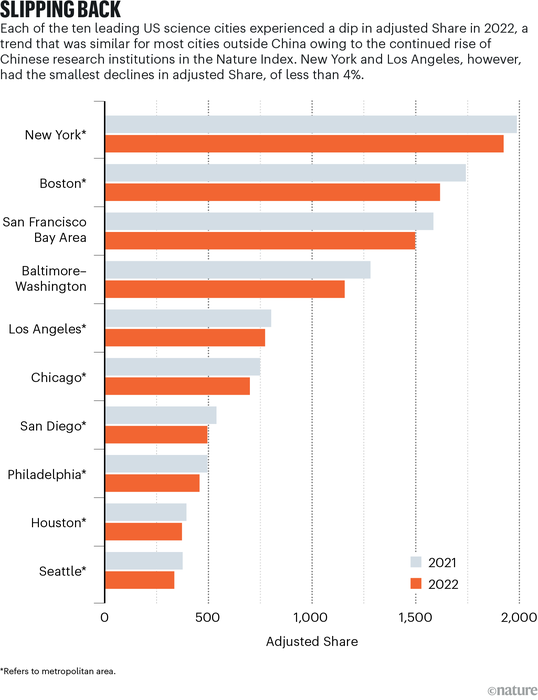
The largest minority population in California’s rural areas is Latinx people. Cheney, who has become fluent in Spanish so that she can engage with community members more effectively, says that the small number of Latinx staff at academic institutions in California, relative to the general population, makes it difficult to involve local voices in research. It can be time-consuming to partner with community members in identifying research needs, incorporating local knowledge and implementing research findings, and it comes at a cost, says Cheney, given that academic career advancement is typically based on publications.
William Porter, who works with Cheney at UC Riverside, says that the Salton Sea’s growing dust problem was too much for him to ignore. An atmospheric scientist, Porter had originally arrived at UC Riverside in 2017 to focus, in part, on wildfire and coastal air quality. But he soon felt an urgent pull. “It’s right here in my backyard,” he says.
Over the past few years, Porter has tailored research programmes to track dust storms and their acute health effects. He’s also launched a project to help the region’s residents to build their own indoor air purifiers using box fans and air filters. Scientists are uniquely positioned to address the consequences of policy indecision when it comes to complex environmental crises, he says, and he sees the Salton Sea’s environmental decline as a pressing opportunity to build research capacity around climate-related problems that are becoming increasingly common worldwide. What’s clear, says Porter, is that the days of the ‘ivory tower’ model of research dissemination are over; academics can no longer just publish a paper and assume the results will be delivered to communities. “That is a broken model,” he says. “The way you conduct community research nowadays is as part of a team with communities.”
As California’s rural areas experience wildfires, flash floods, heatwaves and drought, researchers are asking what they can do to help, says Diana Moanga, who manages the Spatial Analysis Center at Stanford University in California. Throughout her career in California, Moanga has interviewed ranchers affected by dwindling water supplies, helped to create a risk index of mobile homes that are vulnerable to wildfires and assessed the potential for solar projects on tribal lands. Notably, she says, funders want to ensure that research results reach communities. Federal agencies such as the National Oceanic and Atmospheric Administration and the US National Science Foundation will not fund projects that do not set out clear community impacts — as well as a clear plan to disseminate the results back to community members.
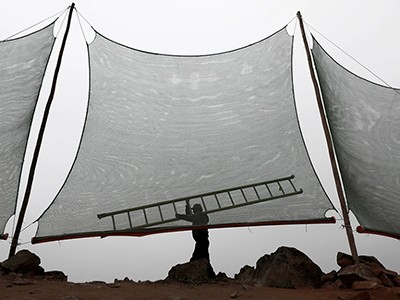
Water crisis: how local technologies can help solve a global problem
Gadgil agrees that rural-community projects must avoid top-down approaches to be successful. In fact, his team always asks community members how else they would like to use scientists’ skills. Most often, the researchers provide teaching modules on making drinking water safe. They have even helped rural students with their science-fair projects. In his experience, if locals aren’t engaged, “as soon as you leave, the intervention will die”. It’s important to set appropriate expectations when embarking on a project, he says, by explaining how the science works, and emphasizing that a few failures might occur before the problem is solved.
Better yet, says Susana Matias, a researcher who sits at the nexus between UC Berkeley, the Agriculture and Natural Resources network and community members, is sharing the leadership and decision-making. When analysing data from the state’s largest farmworker population health surveys4, for instance, Matias found increased risk of chronic health conditions, notably obesity, compared with elsewhere in the country.
For example, in one project, Matias and her team partnered with a berry grower, who allowed them to run a health-promotion programme focusing on diet and exercise with farmworkers in their fields in California5. Although the programme did not measurably improve health outcomes, the researchers think it was highly valuable in engaging the farmworker community. “Roughly half of these populations are potentially undocumented immigrants, so it is key to have community-based partners to help build trust and access,” says Matias, who emphasizes that placing value on community members’ time and expertise is an important way to build mutual respect and workforce capacity.
The value of rural data
Involvement by rural residents is particularly important in medical research. People living in rural areas are more likely to die from heart disease, cancer, chronic respiratory disease and stroke than are urban dwellers, according to the US Centers for Disease Control and Prevention, but securing their participation in trials and surveys can be major challenge. Participants typically have to contribute their time during business hours, which might not be feasible for those in full-time employment, especially when they live far from urban centres. “Rural participants are often excluded from clinical research,” says epidemiologist Jennifer Radin.
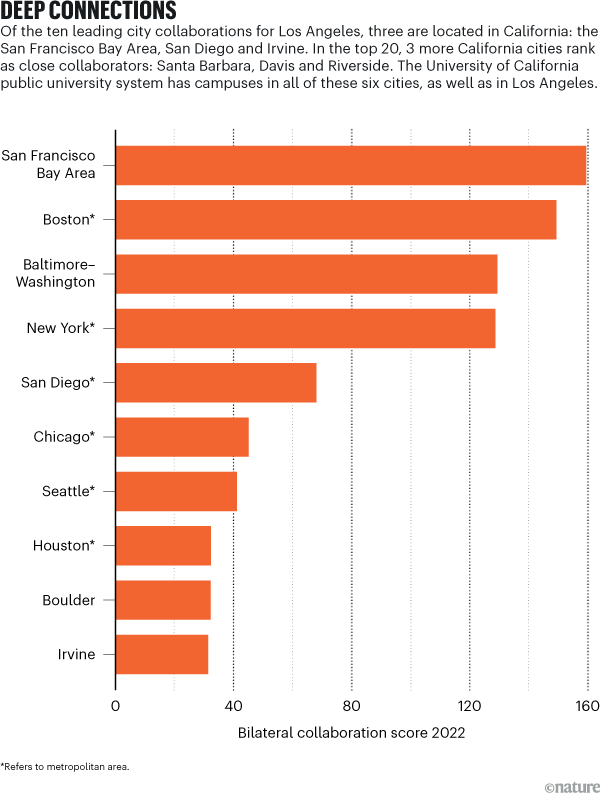
By encouraging participants to engage with studies remotely, Radin and her colleagues at Scripps Research in La Jolla, California, and Johns Hopkins University School of Medicine in Baltimore, have been able to gather high-quality rural-health data. From 2017 to 2019, for example, they ran POWERMOM, a nationwide pregnancy health study in which participants could share data on blood pressure, weight-gain and other factors throughout their pregnancies, through a smartphone app6. Of the 3,612 participants who were initially recruited, 16% had rural addresses — a high percentage compared with previous studies, says Radin. “Doing a completely remote clinical trial allowed us to include everyone,” she says.
In 2020, Radin launched another study, called DETECT, which used wearable devices to predict outbreaks of COVID-19 in the United States. The team also conducted outreach in far-flung locations, such as rural Alaska and Guam, to ensure that diverse populations were represented. The initial results, published last year, showed that symptom and sensor data collected by smartwatches and activity trackers could improve surveillance of COVID-197. “These digital tools can be rolled out anywhere, at any time — not necessarily only when it’s convenient for the researchers, but when it’s convenient for the participant to share their data and experience,” says Radin.
Perhaps the greatest health impact, however, comes from the UC Programs in Medical Education (PRIME), which aim to address California’s looming physician shortage, especially in rural areas, where only 9% of the state’s doctors practise. The programme has resulted in more than 750 medical-school graduates since 2004, and roughly 43% of those graduated from programmes based in or serving rural areas.
It’s projects such as this, which centre societal needs and priorities, that Gadgil hopes will attract greater funding and resources in future, alongside curiosity-driven science. “Research that benefits the communities around us is receiving much more focused attention,” he says.
